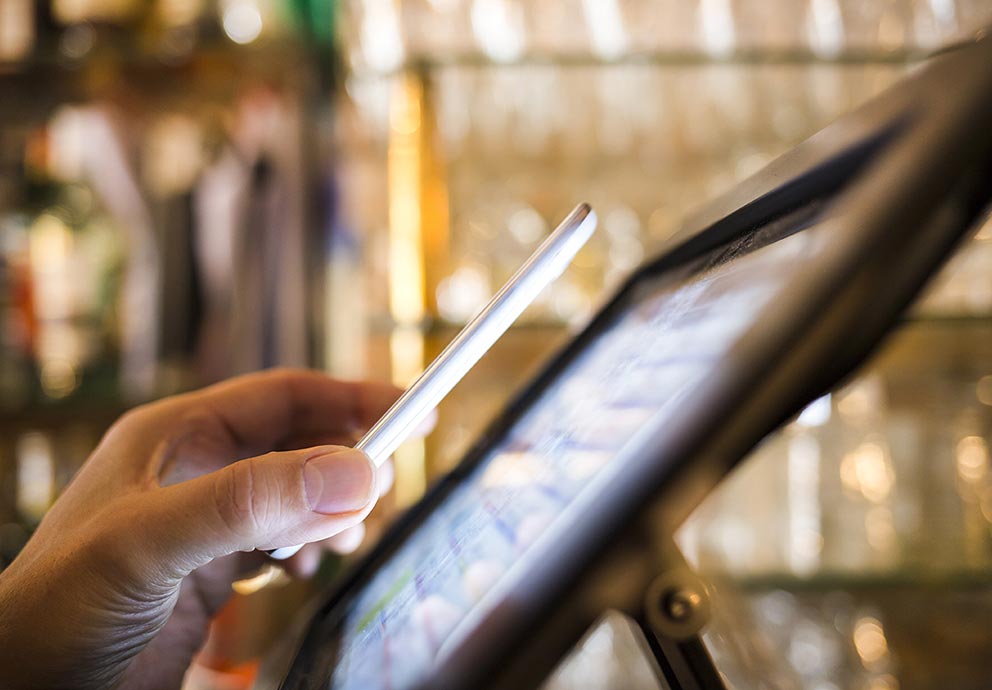With the multiplication of customer journeys (online, in store, click & collect) and the deployment of new wireless technologies, a new revolution of Electronic Payment Terminals (EPTs) is emerging. Retailers are faced with choices that are as technological as they are strategic.
Who still remembers the old card imprinter tools, those things that looked like ironing presses that were used for early credit card payments ? In France, the bank card has since become the main means of cashless payment1 : in 2021, 57 % of the number of transactions were made by bank card (Banque de France data) and new generations of EPT (Electronic Payment Terminal) are regularly appearing on the market. Recently, with the rise of contactless thanks to the Covid effect (for amounts under €50), these devices, so recognisable with their small screens and keyboards, have come to fill the additional space dedicated to contactless.
In 2019, there were more than 2 million EPTs in France, according to Statista. But the renewal rate has accelerated, at a time when the boundaries between checkout, self-scanning, payment terminals, order terminals and digital tablets are becoming blurred. The EPT market, historically dominated by Ingenico and Verifone, is moving towards more mobile, more connected, more tactile and more versatile options.
It has been more than 5 years since players such as Boulanger and Sephora, following the example of Apple, have acquired mobile POS tools at the point of sale. This was done in order to reduce queues at the checkout, but also to streamline the in-store experience, by giving salespeople the means not only to advise (on the features of in-store stock products) but also to collect payments, so as not to « break the shopping experience ». Several beauty and pharmacy brands are also in the process of equipping themselves, to combat bottlenecks during peak times. Because mobile payment is continuing its breakthrough.
The Marionnaud beauty brand (1,100 stores) has therefore equipped itself with a solution on smartphone and tablet, which allows its in-store salespeople to collect payments anywhere, at the checkout or on the shop floor, and to process all omnichannel journeys (e-reservations, customer orders, ship from store, etc.). This solution proposed by Keyneosoft is linked to a payment collection application.
Mobile payment terminals are being adopted more and more, in a simplified form, by independent merchants, pop-up stores and small shops. Small businesses (food trucks, grocery stores, concept stores, etc.) have popularised these small boxes, which are essentially mobile card readers. Paired with smartphones, they allow users to pay by card, including contactless payments (for amounts under €50).
But a new generation of SmartPOS promises to be a game changer. Thanks to the open-source operating system of Google Android, this type of equipment is capable of offering many applications (sending receipts by email and SMS, split payments, tips or customer reviews module, digitised history, etc.). These smart EPTs are being tested in particular by the Carrefour group, which sees them as a way of meeting customers' demand for simplification and time savings. On their screens, which are larger than those of conventional EPTs, Carrefour customers can see how many loyalty points they have collected, or even receive promotions before completing their purchases.
Finally, some are considering the partial disappearance of EPTs, at a time when smartphones are becoming more popular as payment terminals. This option sees the new terminals replaced by applications, which take advantage of the features of smartphones. Today, their deployment is limited by several factors : they are limited to purchases below €50 (contactless payment limit), and are not suitable for payment by weight (weighing fruits and vegetables, for example), or in cash. In luxury or fashion, their deployment is nevertheless set to accelerate from 2023, when the future FR V6 bank card standard will allow consumers to pay contactless for amounts over €50, by typing their code directly on the tablet, without having to insert their card. For brands, this system is financially more attractive : they only pay for the subscription to the POS application without having to equip themselves with EPTs. Apple's announcement, with the Tap To Pay feature that allows retailers to accept contactless payments via an iPhone, is heading in this direction.
For both integrated retailers and franchisees, the challenge is to invest in solutions that meet their objectives, without falling for the fad. Because choosing a new EPT model has an impact, both on customer relations (payment experience, loyalty), and also on operational efficiency (new « smart » systems often integrate data management, but also back office management such as inventory and orders). This involves finding, depending on your business type, the easiest solutions to integrate in store (size, design, team training, compatibility with existing IT systems) and... the least expensive solution. This is done in the long term, by integrating maintenance costs (software updates, additional purchases of applications).
1 Cashless payment methods (card, transfer, direct debit, cheque, etc.) are methods that allow the transfer of funds held in accounts following the delivery of a payment order. They are the opposite of cash (notes and coins)



